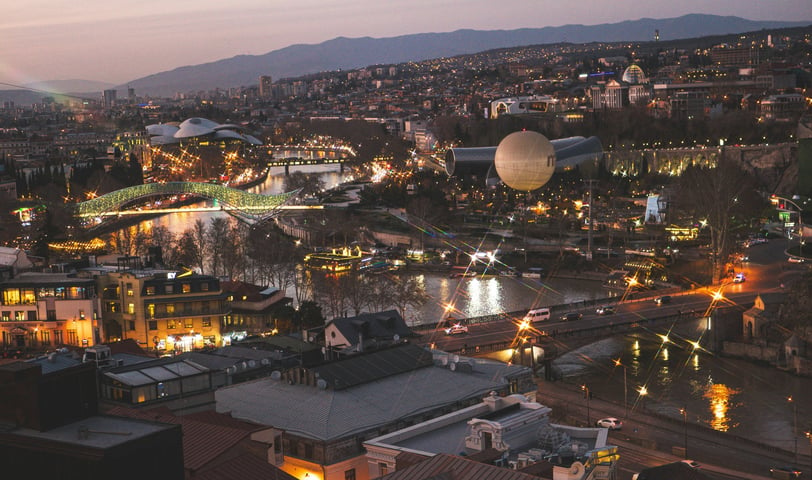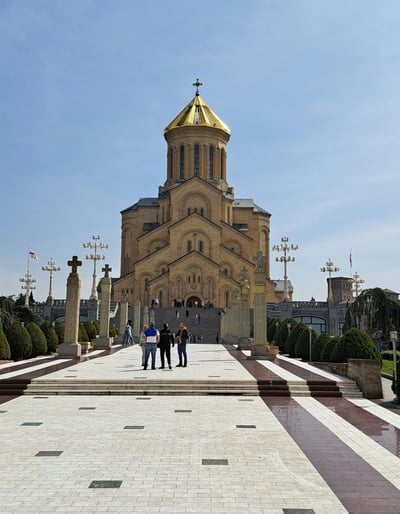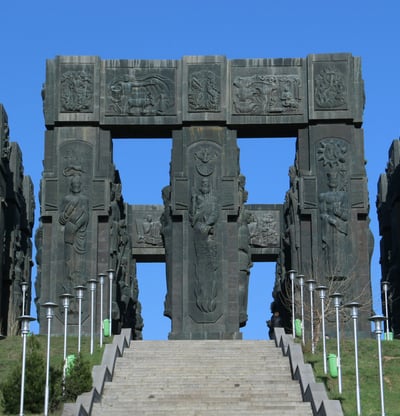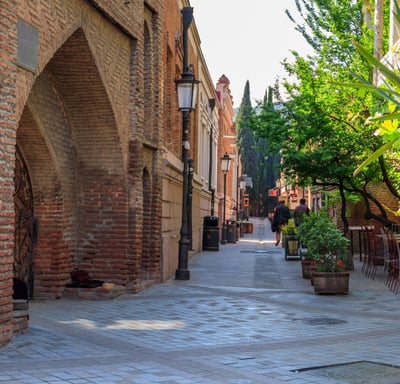Tbilisi Travel Guide: Where Sulfur Steams and Memory Dances


A City Woven from Mist and Myth
Cradled between mist-wrapped hills at the crossroads of Europe and Asia, Tbilisi—the heart of Georgia, not the American state—is a city that breathes stories. This Georgia, called Sakartvelo by its people, traces its name to Gurjistan in Persian lore, a land of ancient script and unbroken spirit. Here, sulfurous steam rises from age-old bathhouses, curls around the cracked wooden balconies of Sololaki, and drifts through alleyways painted with rebellion and reverie. Tbilisi is not a place to rush. It unfolds slowly, like a memory whispered or a poem etched in stone.
The city’s ravines and terraces cascade toward the Mtkvari River, a 1,511-km thread from Georgia’s highlands to the Caspian Sea. By dawn, its waters mirror the sky’s shifting moods; by dusk, they carry the glow of lanterns like scattered stars. In Tbilisi, time does not pass—it gathers, in the steam, the stone, the songs.
“In Tbilisi, I saw landscapes like no others. A sun that feels ancient, and people carved from myth.”
— Boris Pasternak


A Tapestry of Empires and Endurance
Tbilisi’s tale began in the 5th century, when King Vakhtang Gorgasali’s falcon fell into a steaming spring. From that warmth, named tbili, a city was born—a crossroads of Iberia, Persia, Byzantium, and Russia. Under Soviet rule (1921–1991), Tbilisi bore industrialization’s weight yet cradled a quiet rebellion of art and identity. Since Georgia’s independence, its 1.2 million souls have woven a vibrant cultural capital in the Caucasus, welcoming 1 million visitors yearly.
“Every stone holds a story,” says a guide in Abanotubani, where Tbilisi’s past and present intertwine like its winding streets.
Landmarks and Vistas – The City’s Beating Heart
Tbilisi’s icons are as layered as its history, each a verse in the city’s endless poem. From ancient fortresses to modern cathedrals, these are the places where past and present dance.
1. Narikala Fortress – The Ancient Watch
Narikala Fortress, founded in the 4th century and often called Narikala by locals, perches above the old town, framing Tbilisi’s rooftops and the Mtkvari’s curve. Climb the winding path (1 km, 30 min, moderate) or glide up by cable car from Rike Park (USD 2 round trip, 08:00–22:00). At sunset, its stones glow gold, whispering secrets of empires. Visit early for quiet, and bring a scarf for the evening breeze, as the city unfolds like a map below.
2. Sameba Cathedral – The Golden Flame
Sameba Cathedral, or the Holy Trinity Cathedral, completed in 2004, stands as a beacon of faith, its golden dome piercing the sky. Inside, candlelight dances across frescoes (free entry, 09:00–20:00, dress modestly). The garden’s roses soften its grandeur. Midweek mornings offer solitude’s embrace, where, as a visitor whispers, “Sameba feels like faith carved in stone.”
3. Abanotubani – The Sulfur Sanctuaries
Abanotubani, Tbilisi’s historic bathhouse quarter, is fed by hot springs that define the city’s soul. Orbeliani Baths, with Persian-style tiles, charge USD 20–50 for private rooms (1h, book via +995-32-243-09-03). Gulo’s Thermal Spa, humbler, costs USD 10 (07:00–22:00). The mineral heat melts time away. “Baths are where Tbilisi breathes,” says a local. Book ahead for weekends, and bring flip-flops for the steam.
4. Tbilisi Old Town – The Cobbled Maze
Tbilisi Old Town, known as Dzveli Tbilisi, weaves cobblestone lanes past creaking balconies and ivy-draped courtyards. Sip coffee at Café Linville (USD 3) or savor khachapuri at Sakhachapure (USD 5). Fading frescoes and Soviet relics blend in harmony. Wander at dusk, when lanterns cast a golden hush, and every corner hides a story, as a shopkeeper laughs.
A Pulse of Rebellion and Creation
Beyond the icons, Tbilisi’s quieter gems beckon, each a fragment of the city’s layered soul.
1. Dry Bridge Market – A Living Archive
On the Mtkvari’s banks, Dry Bridge Market (09:00–17:00, free) spills with Soviet medals, vinyl records, and handwritten letters. Bargain for hand-painted icons, often religious Orthodox artworks, priced USD 10–50, or listen to vendors’ tales. Weekdays offer a quieter hunt, where, as a seller notes, “This market holds Tbilisi’s ghosts.”


2. Betlemi Quarter – The Forgotten Verse
Behind Narikala Fortress, Betlemi Quarter’s narrow lanes cradle crumbling homes and grapevine-shaded courtyards. The 5th-century Ateshgah Fire Temple, a Zoroastrian relic, whispers of ancient faiths (free, limited access). Explore on foot with a map, as streets twist like memories. “Betlemi feels like a secret,” says a cyclist passing through.
3. Chronicles of Georgia – The Silent Giants
On a northern hill, the Chronicles of Georgia monument (free, 24/7) towers with reliefs of kings and saints, its solitude otherworldly. Below lies the Tbilisi Sea, an 11.6 km² reservoir reflecting dawn’s first light. Visit at sunrise for stillness, where a taxi driver calls it “Tbilisi’s quiet epic.”
Echoes of Culture – Art as Defiance
Tbilisi’s creative pulse thrives in its post-Soviet rebirth. Street art by GAB (Graffiti Art Brigada) adorns Rustaveli Avenue, while Bassiani club (USD 15 entry, Fridays 23:00–08:00) pulses with techno. Levan Songulashvili’s mystical paintings and Tamta Melashvili’s novels weave memory and rebellion. Polyphonic choirs in wine bars like Alazani (USD 10 drinks) echo ancient traditions, while queer nightlife blooms at Success Bar. Join a street art tour (USD 20, book via Tbilisi Free Walking Tours) or visit Fabrika’s galleries, where a curator declares, “Art is our heartbeat.”
Practical Pleasures – Savoring Tbilisi’s Essence
Tbilisi’s joys unfold where steam meets stone. Begin with its culinary heart:
USD 6 adjaruli khachapuri at Retro, a boat-shaped bread cradling cheese and egg.
USD 1 lamb khinkali at Pasanauri, dumplings best eaten with a twist.
USD 8 qvevri wine at Vino Underground, its earthen notes a nod to Georgia’s 8,000-year winemaking.
From culinary delights to city strolls, explore Rustaveli Avenue’s bookstores or haggle at Dry Bridge Market. Ride the Mtatsminda Funicular (USD 3 round trip, 09:00–23:00) to a park of pines and nostalgia. The metro (USD 0.50/ride) or Bolt taxis (USD 3–5) weave through the city’s folds. Book restaurants for weekends, and carry cash for markets, where food is love, as a Barbarestan chef grins.
Getting There – The Road to Memory
Tbilisi’s gateway, Tbilisi International Airport (TBS), lies 17 km east, where the Mtkvari’s whispers begin. Flights from Europe or the Middle East start at USD 100 (Kayak). Airport buses (USD 0.50, 30 min) or Bolt taxis (USD 10) carry you to the old town’s embrace. For slow travelers, trains from Yerevan (10h, USD 20) or Baku (12h, USD 25) trace rugged hills, while marshrutka minibuses (USD 10–15) cross from Armenia or Azerbaijan.
No visa is needed for most (90–180 days). A city pass (USD 15, 3 days) unlocks metro, funicular, and select museums, threading Tbilisi’s stories into your journey.


Where to Stay – Havens in the Hills
In Tbilisi’s ravines, rest comes with character. Budget wanderers find Fabrika Tbilisi (USD 15/dorm), a creative hostel reborn from a Soviet factory. Mid-range guesthouses in Sololaki (USD 50–100/night) offer warm breakfasts and creaking charm. Luxury seekers choose Stamba Hotel (USD 150–300) for lush design or Rooms Hotel (USD 120–250) for urban flair, each a canvas of the city’s spirit.
Book 3 months ahead for spring or autumn. Park at Freedom Square lots (USD 1/h) if lanes grow tight.
Best Time to Visit – When the City Glows
Tbilisi’s seasons shift from 0°C (32°F) in winter’s hush to 30°C (86°F) in summer’s hum. Spring (April–May) and autumn (September–October) weave mild days (15–25°C) and golden light, perfect for cobblestone strolls. Summer pulses with festivals but hums with humidity. Winter wraps bathhouses in cozy steam, with fewer crowds. Pack layers for evening chills; UV is gentle but persistent.
Tbilisi at a Glance
Before we weave Tbilisi’s future, here’s a glance at its essentials, distilled for your journey:
Sustaining the Soul – Guardians of Memory
Item
Narikala Cable Car
Orbeliani Baths
Mtatsminda Funicular
Metro Ride
Airport Bus
Fabrika Hostel
Stamba Hotel
City Pass
Detail
Round trip from Rike Park
Private room, 1h
Round trip, park access
Single trip
TBS to city center, 30 min
Dorm bed, shared bath
Double room, spring rate
3 days, metro + museums
Cost (USD)
2
20–50
3
0.50
0.50
15
150–300
15
Tbilisi faces urban sprawl and overtourism’s strain, yet its spirit endures through quiet acts of care. The Tbilisi Heritage Group restores Betlemi Quarter’s wooden homes, preserving their grapevine-shaded stories. Bathhouses like Orbeliani Baths adopt solar panels, blending ancient warmth with modern stewardship. Annual festivals, like Tbilisoba, fund local artisans and teach sustainable practices, from qvevri winemaking to upcycled crafts. Choose local guides and buy from Dry Bridge vendors to keep Tbilisi’s memory dancing, as a Fabrika artist urges, “Every visitor shapes our story.”
Where Memory Dances
Tbilisi calls to all—poets lost in Dzveli’s lanes, families savoring khachapuri, seekers soothed by sulfur baths. Artisans at Dry Bridge Market weave stories, while Narikala’s stones guard ancient truths. Support a local vendor or join a community-led tour (USD 15) to weave your thread into Tbilisi’s tapestry. Plan your 2025 journey, where steam and stone await your story.
Beyond the steam of sulfur baths and the ancient whispers of Narikala, Tbilisi holds intimate tales of bread and bonds. Step into one such story in Travelers' Tales "Khachapuri and the Women of Rustaveli: A Tbilisi Tale."
✉️ Contact:
Curated by TrueTrip Hub |
© 2025 Invisible Atlas — All rights reserved.
Invisible Atlas
Journey Beyond the Visible
invisible.atlas@truetriphub.com
